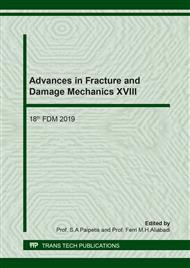p.452
p.458
p.464
p.470
p.476
p.482
p.488
p.493
p.499
Evaluation of Self Weight Deflection Property of GFRTP Laminate at Moulding Temperature and Formability Simulation of Diaphragm Forming
Abstract:
The application of Glass Fibre Reinforced Thermoplastics (GFRTP) is expected to reduce the weight of automobiles. In order to use GFRTP for automotive parts, it is essential to apply Computer Aided Engineering (CAE) technology. Until now, prepreg sheets with thermosetting resin matrix are assumed to be used for materials in simulation software. When FRTP is applied for materials in simulation software, it is required to grasp the characteristics of FRTP under moulding temperature. In our previous study, a system capable of evaluating the tensile properties of FRTP laminates at moulding temperatures had been developed and their tensile properties had been evaluated. Bending stiffness under moulding temperature is also required for simulation software. While bending stiffness can be determined using Young's modulus for isotropic materials, thermoplastic prepregs have large anisotropy, especially at moulding temperature. In this study, a system that enables self-weight deflection test of thermoplastic resin laminate under moulding temperature was developed and self-weight deflection characteristics of plain weave GFRTP were evaluated. The analysed results in which the bending stiffness under the moulding temperature of GFRTP was taken into account, gave the most suitable results to the experimental results.
Info:
Periodical:
Pages:
493-498
Citation:
Online since:
December 2019
Authors:
Price:
Сopyright:
© 2020 Trans Tech Publications Ltd. All Rights Reserved
Share:
Citation:


